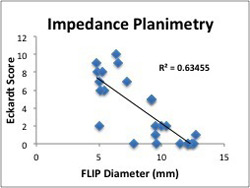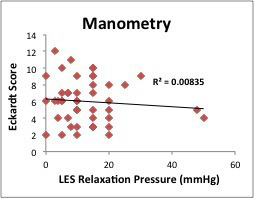|
Back to 2014 Annual Meeting Posters
Impedance Planimetry As a Diagnostic Tool to Evaluate the Degree of Clinical Lower Esophageal Sphincter Dysfunction
Yalini Vigneswaran*1,2, Matthew E. Gitelis1, Gene Chiao1, Joann Carbray1, Michael B. Ujiki1,2
1Minimally Invasive Surgery, NorthShore University HealthSystem, Evanston, IL; 2Surgery, University of Chicago, Chicago, IL
Purpose: Currently we rely on manometry among other diagnostic tools to evaluate patients with lower esophageal sphincter (LES) dysfunction. With the development of new technologies, there may be additional tools to correlate symptoms with physical findings. Functional Lumen Imaging Probe (FLIP) is a novel technology that allows us to measure the distensibility and diameter of the gastro-esophageal junction (GEJ) using impedance planimetry. We hypothesize that the GEJ diameter measured by FILP will correlate with the severity of symptoms in patients with LES dysfunction.
Methods: From 2011 to 2013, all patients that presented to our institution for surgical treatment of achalasia were evaluated preoperatively and postoperatively with reflux severity index and GERD questionnaires along with Eckardt scores as part of an IRB approved prospective database. All patients underwent work up with manometry, pH monitoring and EGD. In 2013, patients were additionally evaluated pre-myotomy and post-myotomy with the FLIP device.
Results: A total of 24 FLIP diameter measurements were performed with corresponding Eckardt Scores. FLIP diameter ranged from 4.8 to 12.6mm and Eckardt scores from 0 to 10, resulting in a significant inverse correlation between FLIP diameter and Eckardt score with a Pearson's correlation of 0.635 (two-tailed, p = 0.00086). Compared to preoperative manometry, a total of 46 patients with LES relaxation pressure that ranged from 0 to 50 mmHg and corresponding Eckardt scores from 2 to 12 poorly correlated, with a Pearson's coefficient of 0.00835 (two-tailed, p= 0.956). Additionally reflux severity index and GERD scores did not significantly correlate with FLIP diameter or LES relaxation pressure in this population.
Conclusions: There is a significant correlation between the measured FLIP diameter at the GEJ and degree of clinical symptoms as described by Eckardt scores, unlike LES relaxation pressure on manometry. We thus postulate that the FLIP technology may be a better physical measure of the degree of achalasia than other current technologies.
 Figure 1. Eckardt score as a function of Functional Lumen Imaging Probe (FLIP) diameter measurement at the gastro-esophageal junction. Pearson's correlation of 0.635 (p=0.00086)  Figure 2. Eckardt score as a function of lower esophageal sphincter relaxation pressure. Pearson's correlation of 0.00835 (p=0.956)
Back to 2014 Annual Meeting Posters
|



